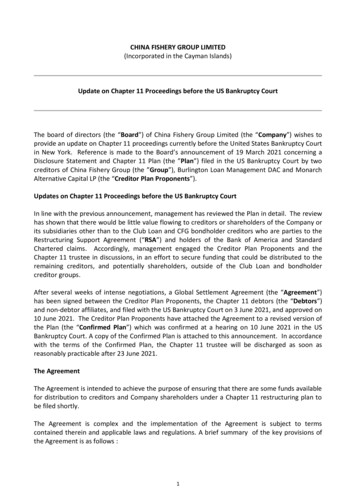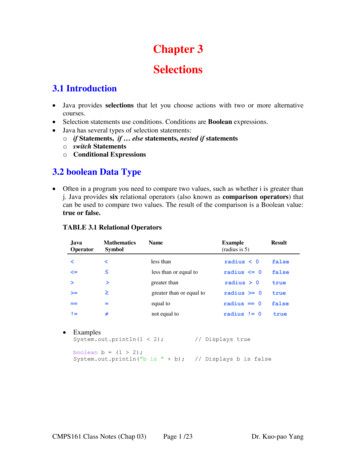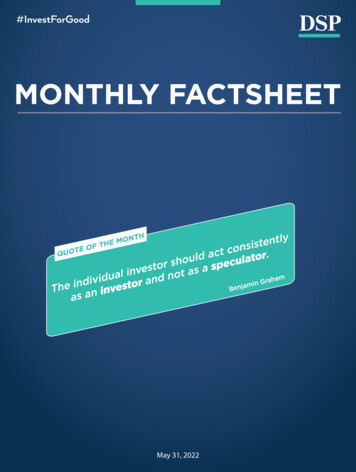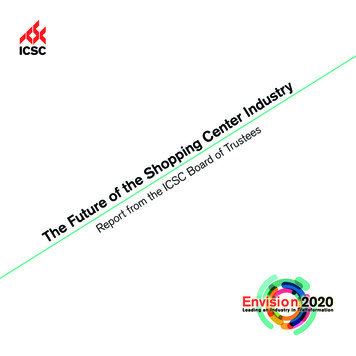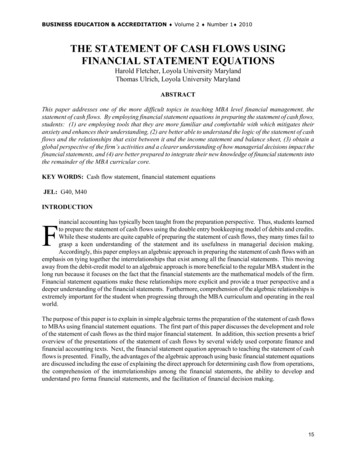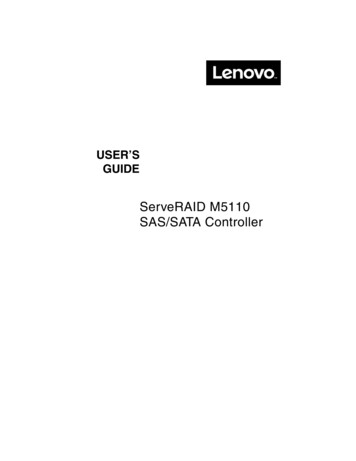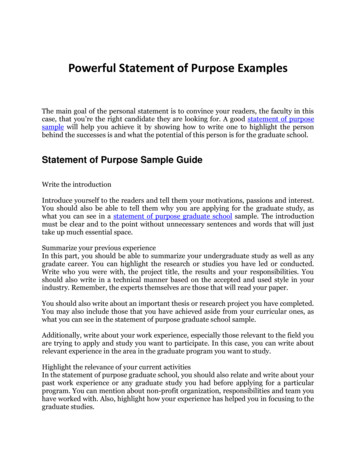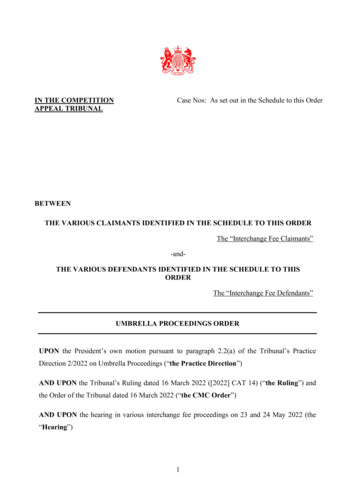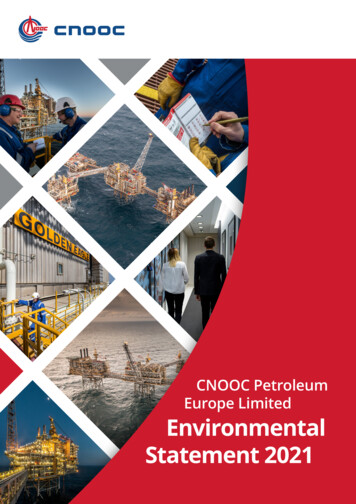
Transcription
CNOOC PetroleumEurope LimitedEnvironmentalStatement 20211
Environmental Statement 2021ForewordEnergy for All
It is my pleasure to present to youCNOOC Petroleum Europe Limited’s (CNOOC)2021 Environmental Statement.We are committed to minimizing our impact on the environment andrecognise that protecting the environment is integral to CNOOC’ssustainable growth.Included in this Environmental Statement is: A description of the facilities operated byCNOOC and the activities carried out in 2021 A summary of our EnvironmentalManagement System (EMS) Environmental emissions and discharges figuresfrom our 2021 operations CNOOC’s 2021 objectives and their progress A brief overview of our key 2022 objectivesDespite the challenges faced due to the globalpandemic, 2021 has been a busy year with a continuedemphasis on developing initiatives that will focus onimproving our impact on the environment: Completion of chemical tank risk assessmentsand issuing of reports and recommendations Scott and Buzzard RBA management plansaccepted and implemented Produced water performance improvementsworks conducted during platformturnarounds (TARs) Flare and vent studies completed Asset based greenhouse gas (GHG) EmissionsReduction Action Plan workshops E-Rep’s National Examination Board inOccupational Safety and Health (NEBOSH)environmental awareness training Zero waste to landfill campaign delivering manymonths of zero waste success Successful review, update and production of 30Environmental Documents and proceduresThese improvements were only possible due to thehard work, commitment and engagement of ourworkforce at CNOOC, who consistently strive toBe the Best and Win Together.32021 has also been a successful year with manymilestones being achieved: The lowest number of PON1 reports forthe organisation Golden Eagle celebrated 3 years PON1 free andCNOOC reached 1-year LTI free The Buzzard field passed the 800 million barrelof oil equivalent (BOE) production milestone inSeptember 2021 All three assets executed extended TARs with nospill or non-compliance events The Golden Eagle infill project completed thefinal milestone with first oil from the final well inthe campaign The Buzzard Phase II (BPII) topside’s modulewas safely and successfully installed on Buzzard,marking a key milestone in the BPII first oil On 21 November 2021, first oil was safelydelivered from the BPII development 9 E-Reps passed NEBOSH EnvironmentalAwareness CourseCNOOC strives to be a leading force for best in classenergy development and recognises the importanceof caring for the environment. Looking forwardinto 2022, CNOOC is committed to progressing ourNet Zero ambitions, further reducing the numberand volume of spills, and achieving challengingenvironmental targets in key performance indicators.I hope that you will find this Environmental Statementboth informative and indicative of the continuedcommitment that CNOOC has to minimising ourfootprint on the UK Continental Shelf.Jiang QingManaging Director, UK
Environmental Statement 2021ContentsEnergy for All
IntroductionHealth, Safety, Environment & Social ResponsibilityAsset InformationScottBuzzardGolden EagleDrilling OperationsAtmospheric EmissionsProduction GHG Emissions as CO2 equivalent (‘CO2e’)CO2e Emissions from Production ActivitiesOil in Produced Water DischargeChemicalsProduction ChemicalsDrilling – Including Well Intervention and Pipeline ChemicalsWasteProduction WasteDrilling WasteLegal ComplianceUnplanned ReleasesRegulatory Non-CompliancesEnvironmental ObjectivesEnvironmental Objectives 2021Environmental Objectives 2022
Environmental Statement 2021IntroductionEnergy for All
CNOOC Petroleum Europe Limited, which will be referred to as ‘CNOOC’ in this document, is a wholly-ownedsubsidiary of CNOOC Limited.CNOOC Limited (the ‘Company’ or ‘CNOOC Limited’, together with its subsidiaries, the ‘Group’), incorporated inthe Hong Kong Special Administration Region in August 1999, was listed on the New York Stock Exchange (code:CEO) and The Stock Exchange of Hong Kong Limited (code: 00883) on 27 and 28 February 2001, respectively. TheCompany was admitted as a constituent stock of the Hang Seng Index in July 2001. The Company’s AmericanDepositary Receipts were listed on the Toronto Stock Exchange (code: CNU) on 18 September 2013.The CNOOC Group is the largest producer of offshore crude oil and natural gas in China and one of the largestindependent oil and gas exploration and production companies in the world. The Group mainly engages inexploration, development, production and sale of crude oil and natural gas.Throughout this statement CNOOC refers to UK operations only.CNOOC is a leading upstream business in the UK North Sea and operator of the Buzzard, Golden Eagle, and Scott assets. Ourstrategy is to maximize the value of our UK portfolio and create new opportunities for safe and sustainable growth. We arecommitted to delivering on the North Sea Transition Deal emissions reduction targets and being a Net Zero energy business in theUK by 2050.76
Environmental Management SystemCNOOC has implemented an Environmental Management System (‘EMS’) aligned with requirements of ISO14001:2015. The EMS is independently verified in line with the requirements of the Oslo/Paris Convention(‘OSPAR’) Recommendation 2003/5, to promote the use and implementation of Environmental ManagementSystems on the UKCS.An OSPAR verification statement with zero comments was reported to the Offshore Petroleum Regulator forEnvironment and Decommissioning (‘OPRED’) in May 2021. The next EMS OSPAR verification is scheduled forApril 2023.Environment Representatives (E-Reps)CNOOC E-Reps continue to provide valuable support to offshore workforce engagement during variousactivities including: Roll out of procedures and environmental initiatives Reduction of waste, including the ‘Zero Waste to Landfill’ Initiative Spill reduction, OPEP awareness drills and environmental hazard identification programs Area inspections Supporting environmental audits and inspections Identification and trialling of new environmental training options7
Environmental Statement 2021Health, Safety,Environment &Social ResponsibilityThe HSE&SR Policy shown below, details the beliefs, values andprinciples governing the management of HSE&SR within CNOOC.Energy for All
Our commitment toHealth, Environment, Safety& Social ResponsibilityThis Policy Commitment underpins therequirements outlined in the CorporatePolicy Framework and applies to all activitiescarried out by and under the control ofCNOOC Petroleum Europe Limited, itsbranches and subsidiaries (CPEL).Within CPEL, the Board of Directors ownsand takes responsibility for our overallHSE&SR performance working with ourexecutive leadership and functional teams.We believe that management and staffcommitment to HSE&SR is essential toensuring a healthy, safe and environmentallyacceptable operating environment.We see our people are our most importantasset and we will not compromise ourHSE&SR standards to achieve othercorporate goals, in so far as it is reasonablypracticable. As such, we value the experience,professionalism and integrity of ourworkforce, and the commitment, leadershipand accountability of all personnel for ourHSE&SR performance.We integrate HSE&SR planning andmanagement into our day-to-day activities,defining individual responsibilities, authorityand accountability. By providing adequatecontrol of HS&E risks arising from our workactivities, we strive to prevent accidents,injuries and cases of work related to ill health,damage to equipment and the environment.Process SafetyCPEL applies the principles of Process SafetyManagement to maintain the integrity of ouroperations.We ensure that risks associated with majoraccident hazards, arising out of our offshoreoperations, are identified and controlled.Environmental ManagementCPEL is committed to integrating responsibleenvironmental management into all aspects ofits operations.Our EMS provides the framework for settingand reviewing environmental targets andobjectives, and the process by which the EMSis documented, implemented and maintained.Our actions will support the prevention ofpollution and the reduction of wastegeneration.Energy and Emissions ManagementCPEL measures, monitors and controls ourenergy consuming and emissions producingpractices with the aim of creating a netreduction in greenhouse gas emissions incontribution to a lower carbon economy.Occupational Health and PersonalSafetyOur Net Zero business plan aligns withCNOOC’s principles of green development toenable a low carbon energy future and achieveemissions neutrality by 2050.We strive to optimise the safety of all ourworksites by contracting those contractors whocan demonstrate that they have suitable HS&Eperformance and management systems inplace. In addition, we ensure that emergencyresponse capability is in place and periodicallytest for all our operations and facilities.We ensure all workers are competent to carryout their tasks, in so far as they can impact onJiang Qing10CPEL maintains safe and healthy workingconditions, by providing and maintaining safeplant and equipment, and ensuring that theuse and handling of substances is carried outsafely.We meet all applicable regulatoryrequirements, as well as other compliancerequirements to which we subscribe, andstrive to deliver continuous improvement inour HSE&SR performance.CPEL consult with our people on mattersaffecting their health and safety workingconditions, plant and equipment, and provideappropriate HSE&SR information, instruction,training and supervision to employees andcontractors.ECN-HS-POL-00065Revision 11.0, February 2022the health and safety of themselves and thosearound them, or the environment. Managing Director UKSocial ResponsibilityWe are committed to behaving ethically andcontributing to economic development whileimproving the quality of life of the workforceand their families as well as the localcommunity within the sphere of our activities.At regular intervals the Board of Directorsreviews and revises this policy, as necessary.The Directors of the company each individuallyand collectively share the commitment and willseek to act as Directors in accordance with theabove principles.
Environmental Statement 2021Asset InformationEnergy for All
Production OperationsScottFACTThe Scott asset commenced production in 1993.Location141 kilometres north-east of Rattray Head, PeterheadBlock NumberBlock 15/22DiscoveryDateThe Scott field was discovered in 1987 and came onstream in 1993Water Depth142 MetresTie BacksTelford and Rochelle fieldsInfrastructureThe Scott installation consists of two steel jackets,the Drilling/Production (DP) platform and the Utilities/Quarters (UQ) platform linked by two bridgesExportOil is exported via a subsea pipeline into the Ineosoperated Forties Pipeline System (FPS) to the Kinneilreception terminal on the Firth of Forth. Gas is exportedvia the Wood operated Scottish Area Gas Evacuation(SAGE) system to St Fergus in north-east ScotlandBuzzardFACT11Buzzard achieved 5 years hydrocarbon release free in January 2022.Location55 kilometres north-east of Rattray Head, PeterheadBlock NumberBlock 20/06aDiscoveryDateThe Buzzard field was discovered in May 2001and came on stream in January 2007Water Depth96 MetresTie BacksN/AInfrastructureThe Buzzard installation consists of four platforms(Wellhead, Production, H2S sweetening and UQ)supported by steel jackets which are interconnectedby three bridgesExportOil is exported from the Buzzard installation via a subseapipeline into the Ineos operated FPS to the Kinneilreception terminal on the Firth of Forth. Gas is exportedvia the Frigg system to St Fergus in north-east Scotland
Golden EagleFACTGolden Eagle has an exceptional safety record spanning over7 years LTI free.Location65 kilometres north-east of Rattray Head, PeterheadBlock NumberBlock 20/1SDiscoveryDateThe Golden Eagle and Peregrine fields werediscovered 2007-2009. First oil was produced in lateOctober 2014Water Depth104 MetresTie BacksSolitaire and PeregrineInfrastructureThe Golden Eagle field consists of two subsea drillingcentre manifolds (Northern and Southern), tiedback to two installed bridge-linked platforms (GEADplatform complex)ExportOil and gas from the development is processed at theGEAD platform complex, with gas exported to the SAGEexport line via the Ettrick pipeline end manifold, andoil exported to the Flotta Terminal via a tie-in at theClaymore field12
They may say:Drilling OperationsNoble Sam HartleyRig NameNoble Sam HartleyTypeJack-UpWells Drilled in 2021 20/01-G18 (BPG) 20/01-G19 (CPE)Borr Prospector 513Rig NameBorr Prospector 5TypeJack-UpWells Drilled in 2021 22/26d-3, Glengorm South 22/21c-14, Glengorm Central
Environmental Statement 2021AtmosphericEmissionsEnergy for All
Production GHG Emissions as CO2 equivalent (‘CO2e’)The chart below shows a decrease in combined CO2e emissions from 791,598 tonnes in 2020 to 737,790 tonnesin 2021.These figures are predominantly the CO2 emissions from combustion reported under the Emissions TradingScheme (ETS), but also include the non-combustion GHG emissions from turbines, flaring, venting, fugitives andHydrofluorocarbons (HFCs). These non-combustion and non-CO2 gases are converted to their CO2 equivalentsusing their global warming potentials.All assets showed a decrease in CO2e emissions in 2021. During TARs there is a reduction in power demand andtherefore CO2 emissions. This decrease in CO2 in 2021 is predominately due to there being extended productionoutages for the TARs. Despite emissions from diesel use increasing, power generation related emissions andflare emissions were lower than the previous year.Flare and vent management plans were also implemented which included a requirement to record periods ofelevated flaring as events in the CNOOC incident reporting system. This activity has ensured elevated flaring rootcauses are identified, actioned where appropriate, and lessons learned to prevent reoccurrence. Despite this,Scott power generation reliability decreased in 2021 resulting in reduced gas plant availability and increasedflaring. However, implementation of the flare standard has also helped to decrease emissions from flaring fromBuzzard and Golden Eagle in 2021.CO2e Emissions from Production ActivitiesOffshore Tonnes CO2e Emissions 2018 - 2021GHG emissions from CNOOC’s offshore installations by tonnes CO2e, between 2018 and 202115
GHG Emissions Intensity 2018 to 2021 ComparisonGHG Emissions intensity in kg CO2e per BOE, CNOOC Offshore AssetsEmissions intensity is a productivity and efficiency ratio which expresses the GHG impact in kilogrammes ofCO2e emitted divided by the production output (in BOE). A decreasing intensity performance will reflect apositive and more efficient performance improvement in terms of less GHG emitted per unit of production.Overall, there is an increasing trend in emissions intensity. This is expected as production declines, particularlyon older installations like Scott where production is significantly reduced but the power requirementsremain relatively stable due to the demand for more water to be injected to maintain reservoir pressure.This metric is commonly used to compare performance between assets, though doing this can be misleadingand must be put in context of the asset, the basin and the product type. It also fails to take account of anydownstream processing.16
Environmental Statement 2021Oil in ProducedWater Discharge(PermittedDischarges)Energy for All
Oil in Produced Water DischargeThe mass of oil discharged decreased from 115 tonnes in 2020 to 73 tonnes in 2021. This is due to improvedperformance/optimisation of chemical additive (demulsifier) along with improvements to produced waterhandling facilities implemented during the asset TARs in 2021.Total water volume discharged decreased on all assets due to the extended production outages for the TARsundertaken in 2021. This decrease in production uptime reduced overall produced water generation anddischarge. Scott also had reduced production rates during a period of gas lift outage resulting in less producedwater generation and discharge.Water re-injection decreased on Buzzard and Golden Eagle in line with the reduction in produced water.Produced water re-injection is an important process as it maintains reservoir pressure for improved productionand reduces overboard discharge of oil and chemicals in produced water. This is especially noticeable onBuzzard and Golden Eagle where produced water re-injection uptime is high resulting in very low producedwater discharges. The Scott platform does not have produced water re-injection capability.Average oil in produced water concentration also decreased as a result of improvements made to the producedwater systems during the TARs.Oil in Produced Water Discharged Per Asset18
Environmental Statement 2021ChemicalsEnergy for All
Production ChemicalsThe decreasing volume of produced water due to less production uptime on all assets meant less chemicalswere used and discharged. The Scott asset undertook two TARs last year, and the Telford field was shut infor the last four months of the year. As the majority of Scott/Telford production chemicals are disposed ofoverboard (75-80%), there was a significant reduction in overall chemical volume discharged.Chemicals which are hazardous to the marine environment are subject to substitution (SUB) warnings underthe Harmonised Mandatory Control Scheme. Usage of production chemicals with SUB warnings decreasedfrom 1,163 tonnes in 2020 to 1,048 tonnes in 2021. Due to TAR downtime across the three assets this decreasewould have been substantial. However, the decrease in SUB chemical use was offset by chemicals used on bothBuzzard and Golden Eagle, Permtreat PC-191 and Transaqua HT2, both gaining SUB warnings during 2021.However, the SUB chemical discharged weight was approximately half of that in 2020 due to the majority of theSUB chemicals used on Buzzard and Golden Eagle being re-injected into the reservoir or exported (85-90%).Production Chemical UsageProduction Chemical Usage with Substitution Warnings20
Drilling – Including Well Intervention and Pipeline ChemicalsChemical usage has steadily decreased from 28,938 tonnes in 2019 to 15,963 tonnes in 2021. This is due to adecrease in drilling, well intervention and pipeline activities since 2019. Discharged weight also decreased forthe same reasons.The use of SUB labelled chemicals for drilling decreased substantially from 146 tonnes in 2020 to 58 tonnes in2021. Overall discharge of chemicals with SUB warnings also decreased from 9 tonnes in 2020 to 0.25 tonnes in2021. This correlates with the lower drilling activity in 2021 in comparison to the year before.Drilling Chemical UsageDrilling Chemicals Usage with Substitution Warning21
Environmental Statement 2021WasteEnergy for All
Production WasteIn 2021 circa. 1505 tonnes of waste was generated across all installations, which is an increase from the 749tonnes of waste generated in 2020. This is attributable to the extended TARs across the assets. With the lackof TAR outages in 2020 activities were extended into 2021 increasing the overall waste generated. With a zerowaste to landfill focus across CNOOC operations, less waste was disposed of to landfill with alternative methodsand routes being utilised where possible. The majority of the waste from the TARs was subject to dischargeunder consent/treatment.Production Waste Disposal Routes – By Year23
Drilling WasteDrilling waste generated (excluding cuttings) in 2021 was circa. 4,178 tonnes whereas 2020 was circa. 3,171tonnes. Despite slightly less drilling activity overall in 2021, both the Prospector 5 and the Noble Sam Hartleycame to the end of their contracts during this period. This entailed the cleaning of all pits and silos prior torelease of the mobile offshore drilling units (MODUs), generating large volumes of slops and excess chemicalsfor disposal/treatment.Noble Sam Hartley cuttings and slops were treated offshore in 2020 and 2021. A large volume of cuttings andslops from the Prospector 5 were sent onshore for treatment. The Glengorm wells generated larger volumes ofdrilling cuttings due to the hole geometry on both wells i.e., deep, large diameter hole sections used on both thecentral and south wells. Scott also had to skip and ship cuttings onshore during 2021.Drilling Waste Generated (Excluding Cuttings)Drill Cuttings Waste Generated24
Environmental Statement 2021Legal ComplianceEnergy for All
2021 Unplanned ReleasesDuring 2021, there were 8 unplanned releases, a decrease from 14 releases in 2020. This figure does not includepermitted discharge notifications or ongoing PON1s. This is the lowest recorded number of PON1 reports forCNOOC operations. The majority of releases were from the Buzzard and Scott assets. Golden Eagle have notrecorded any PON1 releases since 2018.Individual Installations – PON1 SummaryThe majority of spills were hydrocarbon releases resulting in 0.81 tonnes of oil being released to sea, an increasefrom the 0.0016 tonnes released in 2020. This higher spill volume is largely attributed to the hydraulic oil leakPON1 on the Prospector 5 drilling rig in April.The remainder were chemical releases, resulting in 0.01 tonnes of chemicals being released to sea, a decreasefrom 0.72 tonnes in 2020. There was a large decrease in chemical spills overall, dropping from 11 chemicalPON1s in 2020 to 3 in 2021.In addition to the above, there were also 2 permitted discharge notifications submitted to the regulator in 2021from the Buzzard asset. This was due to a recurring issue at the start of the year with the produced water/opendrains caisson resulting in a sheen during pumping operations. This issue was resolved in the second half of the year.PON1 Summary: 2016-202126
2021 Regulatory Non-CompliancesIn addition to CNOOC reporting unplanned oil and chemical spills associated with offshore activities, CNOOCare also required to submit notification to the Regulator in the event of a non-compliance with the currentlegislative regime.OCROPPCEIA(Offshore(Oil Pollution(EnvironmentalChemicalPrevention andImpactRegulations)Control) NonAssessment)Non ComplianceComplianceNon ComplianceDischargePendingAnalysisUK kGolden EagleDrilling RigsVessels11The majority of non-compliances were OPPC related and due to oil in produced water samples breaching the100mg/L limit. The Buzzard OCR non-compliance was due to a treated seawater leak from a sea water dumpcaisson and the vessel non-compliance was during the BPII subsea campaign where chemical use was exceeded.27
Environmental Statement 2021EnvironmentalObjectivesEnergy for All
Environmental Objectives 2021The 2021 Environmental Objectives were delivered as follows:2021 mentsProgrammePerformance Improved energy & emissionsmanagement systems and monitoringand reporting mechanismsPublish methane strategyAsset flare, vent and fugitiveemissions management plansUndertake asset environmentalstewardship workshops andpublish plansUK ETS transition ongoing Environmental considerations duringplanning and risk assessment formajor TARsAwareness campaign focus on permitcompliance and lessons learnedWork with chemical managementvendor to promote the greening andoptimisation of chemical useChemical tank risk assessmentsPublish and implement producedwater management plans – Buzzardand Scott5 yearly Oil Pollution Emergency Plan(OPEP) review for ScottISO 14001 alignment improvementsEnvironmental field evaluations –ops and drilling Working directly with wastemanagement and supply chain toidentify new waste managementoptions away from landfill andlook at opportunities to supportcircular economyE-Rep led trials of new recycling,composting and source reductionoptions offshoreSupport E-Reps with engagement,training and awareness presentationsContinuation of waste managementtraining to offshore operationsZero waste to landfill ongoing EngagementComplianceContinuous improvement Dischargesto sea and EMS Wastemanagementand culture Foundations –every year 29ISO50001 gap analysis completed andimplementation action plan in progressGap analysis completed to integrate methanemanagement, OGMP2.0 assessment completed,and action plans createdAsset workshop outputs used as inputs toemissions reduction action plans (ERAPs)2021 ETS emissions and activity data verificationcompleted with no significant commentsFlare and vent studies completed for Buzzard andGolden Eagle and recommendations included inasset ERAPsSuccessful EMS OSPAR verification withno commentsLowest number of PON1 spill eventsNo spill events associated with the 2021 TARsCompletion of chemical tank risk assessments andissuing of reports and recommendationsScott and Buzzard RBA management plansaccepted and implemented.Produced water performance improvementsworks conducted during TARs resulting in lowerdischarge concentrations on ScottSupply chain engagement sessions initiatedto identify packaging reduction opportunitieswith contractorsNew recycling routes identified – implementationof 100% recycling scheme for plastic tagsE-Reps opportunities for various training courses.Large uptake for the NEBOSH environmentalawareness courseContinued zero waste support, engagement andawareness presentations given9 E-Reps passed 1 day NEBOSH EnvironmentalAwareness CoursePositive OPRED inspections conducted on Buzzardand Golden EagleAnnual compliance evaluation and siteevaluations deliveredQuarterly environmental performance insights
Environmental Objectives 2022The CNOOC Environmental Objectives are to: Manage and minimise emissions from power generation, flare and unburned hydrocarbons Manage and minimise discharges to sea of oil and hazardous chemicals Manage and minimise waste generation within the supply chain and zero waste to landfill Prevent and mitigate significant environmental unplanned/accidental discharges to sea and air2022 Environmental Targets are: 3% reduction in Scope 1 GHG emissions year on year Maintain trajectory towards a target of 10% reduction on 2018 baseline emissions by 2025. Zero waste to landfill Zero significant (enforcement action level) spills to seaThese objectives and targets are supported by an Environmental Management System foundation of: Engagement Compliance Continuous Improvement2022 Objective AreaProgramme Net Zero andemissions reduction Discharges to seaand spills Environmental considerations during planning and risk assessment for2022 TARsAwareness campaigns on permit compliance and environmentalplanning, drains and bunds and other lessons learned as a result of auditsand inspectionsSupport to renewed hydrocarbon release prevention programmeAudit, review and update of environmental barrier control processContinued implementation of produced water management plans – Buzzardand ScottBuzzard OPEP update for Buzzard Phase 2 with updated weathering anddispersibility dataE-Reps engagement on spill risk identification Onshore and offshore waste contractor site auditsWorking directly with waste management and supply chain to identify waste(specifically packaging reduction) opportunities with our contractors tosupport circular economyE-Rep involvement with waste reduction activitiesE-Rep visits to ASCO onshore waste management facilities EngagementComplianceContinuous environmental improvementWaste managementEMS foundationsContinue to improve energy and emissions management systems andmonitoring and reporting mechanisms, including:- ISO50001- Methane action plan- Flaring and Venting- PPC- ETSFacilitate the communication and implementation of the ERAPsCoordinate large combustion plant stack emissions samplingLunch and Learns and E-Rep involvement30
Energy for All
Environmental Management System CNOOC has implemented an Environmental Management System ('EMS') aligned with requirements of ISO 14001:2015. The EMS is independently verified in line with the requirements of the Oslo/Paris Convention ('OSPAR') Recommendation 2003/5, to promote the use and implementation of Environmental Management

